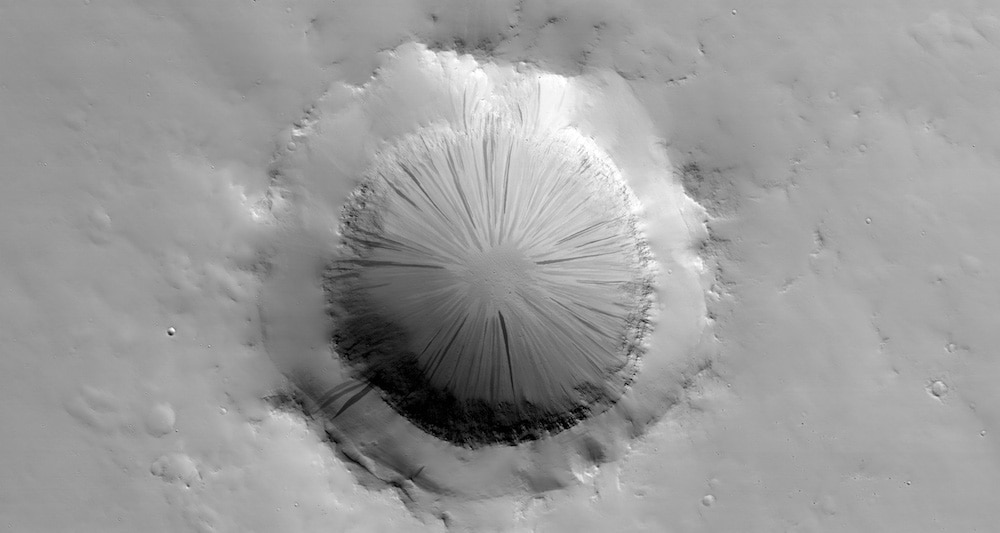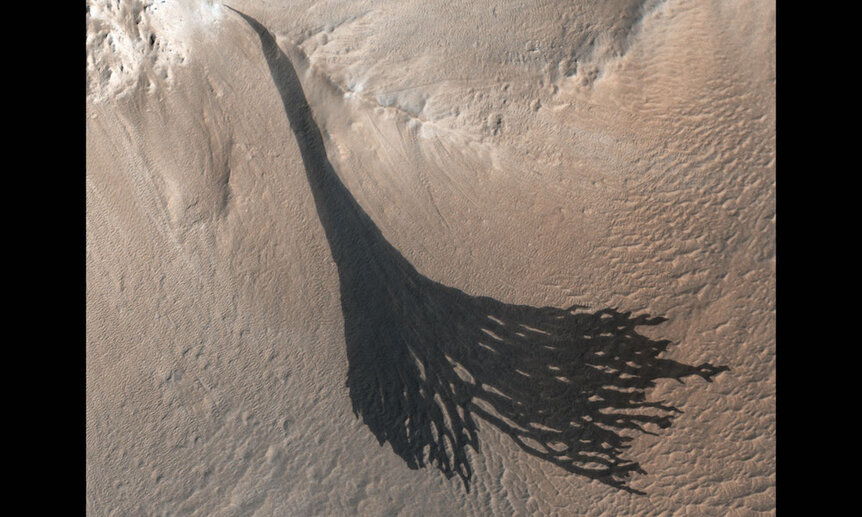Create a free profile to get unlimited access to exclusive videos, sweepstakes, and more!
Invisible dirty dry ice frost avalanches on Mars
Mars is weird, y’all.

In an ongoing attempt to be the weirdest planet in the solar system, Mars apparently has dust avalanches on steep slopes caused by whisper-thin winds generated as dry ice frost mixed in with the regolith sublimates at sunrise and leaves behind dark streaks.
So yes, let’s break this down a bit, shall we?
Mars is farther from the Sun than Earth, and pretty cold. Water exists almost exclusively as ice there. The atmosphere is almost entirely carbon dioxide, and is so thin — less than 1% as dense as Earth atmosphere at sea level — that it’s the equivalent of being three times higher than Mt. Everest.
Still, the Martian atmosphere exists, and the temperature of Mars swings enough that at high latitudes and at night it gets cold enough that CO2 can precipitate out of the air as frost — dry ice frost. This happens everywhere on Mars, though in some places it gets warm enough, roughly -80° C or -100° F, that it can sublimate, turning from a solid into a gas, becoming part of the atmosphere once again.
There are several spacecraft orbiting Mars, and they can see this frost forming and dissipating on the ground. One such orbiter, Mars Odyssey, is equipped with an infrared detector that is sensitive to thermal emission — basically, stuff glowing in the far-infrared due to its own heat; that is, anything above absolute zero — and can see this frost ranging widely over Mars, especially at dawn. It’s seen at all latitudes, even near the equator.
But then things get strange. When they use a visible light camera, one that detects the kind of light we see, it sees that same frost at the same time in some places, but not all of them. There are locations where the thermal imager definitely detects frost, but when you look at visible light… nothing. This tends to happen at lower latitudes, closer to equator.
At those latitudes Mars is lousy with small grains of dust made of iron oxide — rust — that give the planet its familiar ochre hue. These grains are very small, just 1 - 2 microns wide, about a hundredth the width of a human hair, and they coat everything. A new study looking at the dry ice frost at low latitudes links the dust and the lack of visible frost. The scientists think the carbon dioxide frost forms in the thin layer of dust, mixed with it: Dirty dry ice frost [link to paper].
That makes sense; where the frost forms on rocks and other exposed surfaces it would be easy to spot in visible light, since it’s whiter than the gray basaltic rocks ubiquitous on Mars. But if it’s mixed in with the reddish dust it would be much harder to see, despite thermal infrared images making it obvious enough.
OK, well, that’s neat. But there’s more.
There are some odd streaky features seen on slopes on the planet, hillsides and crater rims, called — to be a little on the nose — slope streaks. They can be quite dark and look very much like material flowing down the inclines, sometimes branching out like river deltas as they do. They’re very likely avalanches of dust moving downhill, taking a few hours to go from start to finish. What triggers them isn’t known*.
But the scientists in the new work have an idea. If the frost is mixed in with the surface dust in a layer a few microns deep, then at sunrise the Sun warms it and it sublimates. This creates a weak vertical flow of carbon dioxide gas, disturbing the dust grains. That would be enough, on steep slopes, to trigger a cascade of dust flowing downhill. Voilà! Slope streaks.
Amazingly the wind from the dry ice sublimation moves at just a centimeter or two per second. A casual walking speed is a hundred times faster! But in the thin atmosphere and lower gravity that’s enough to dislodge the dust and generate the flow.
This doesn’t happen often; slope streaks are relatively rare, so the conditions needed to form them must not be too common on Mars. And while this idea is consistent with all the observations there may yet be more going on. That’s almost always true in science, and needs to be checked. Observing the Martian surface at sufficient resolution at dawn isn’t all that easy, especially seeing the same spot more than once over the course of an hour or so; satellites move rapidly and usually don’t fly over the same spot over and over again all in a row. And while this isn’t a high-priority experiment, it would be nice if future missions could somehow perform those sorts of observations.
Mars is just a really weird place when compared to Earth. The thinner air, different atmospheric composition, colder temperatures, and more all make it behave really differently than what we’re used to. But it shows us what other planets are capable of, which broadens our knowledge of how environments can interact.
As our own Earth changes, too, the more we understand about wider ranges of conditions, the better. Studying Mars and the other worlds in the solar system can help us better understand our home.
*Note these are different than recurrent slope linea, which are seasonal and take many weeks to form. These may be due to downhill movement of larger particles like basaltic sand.





























